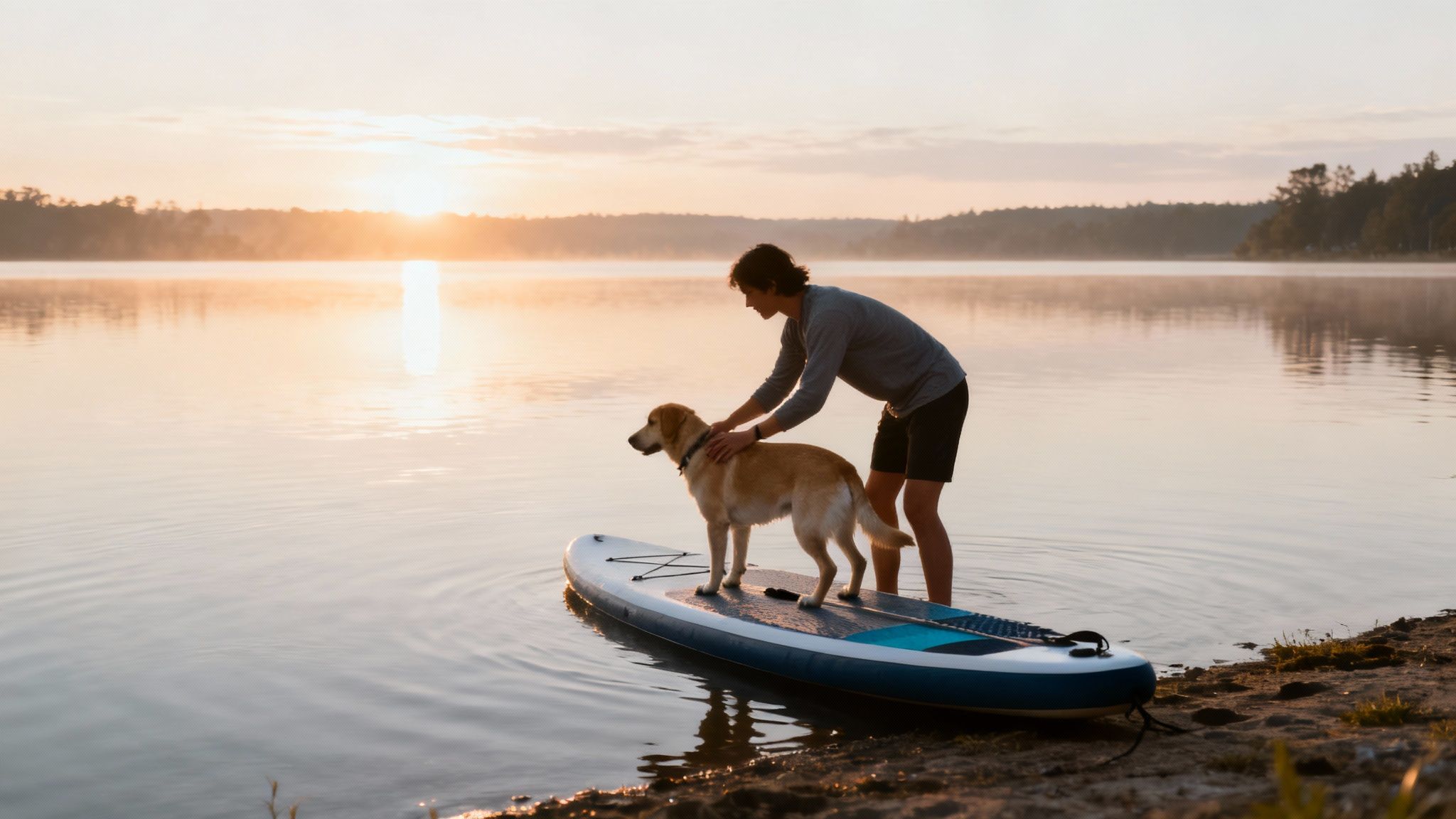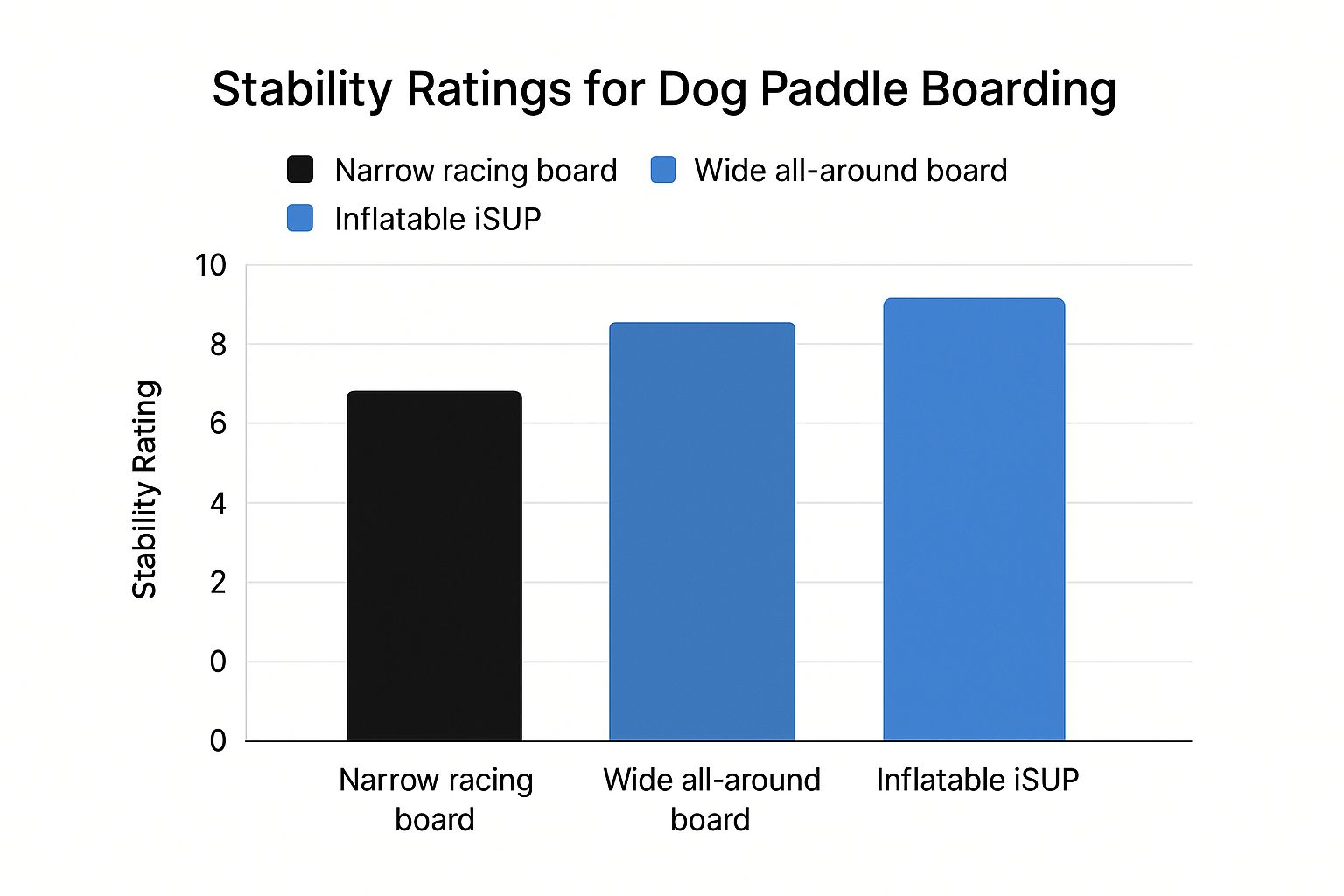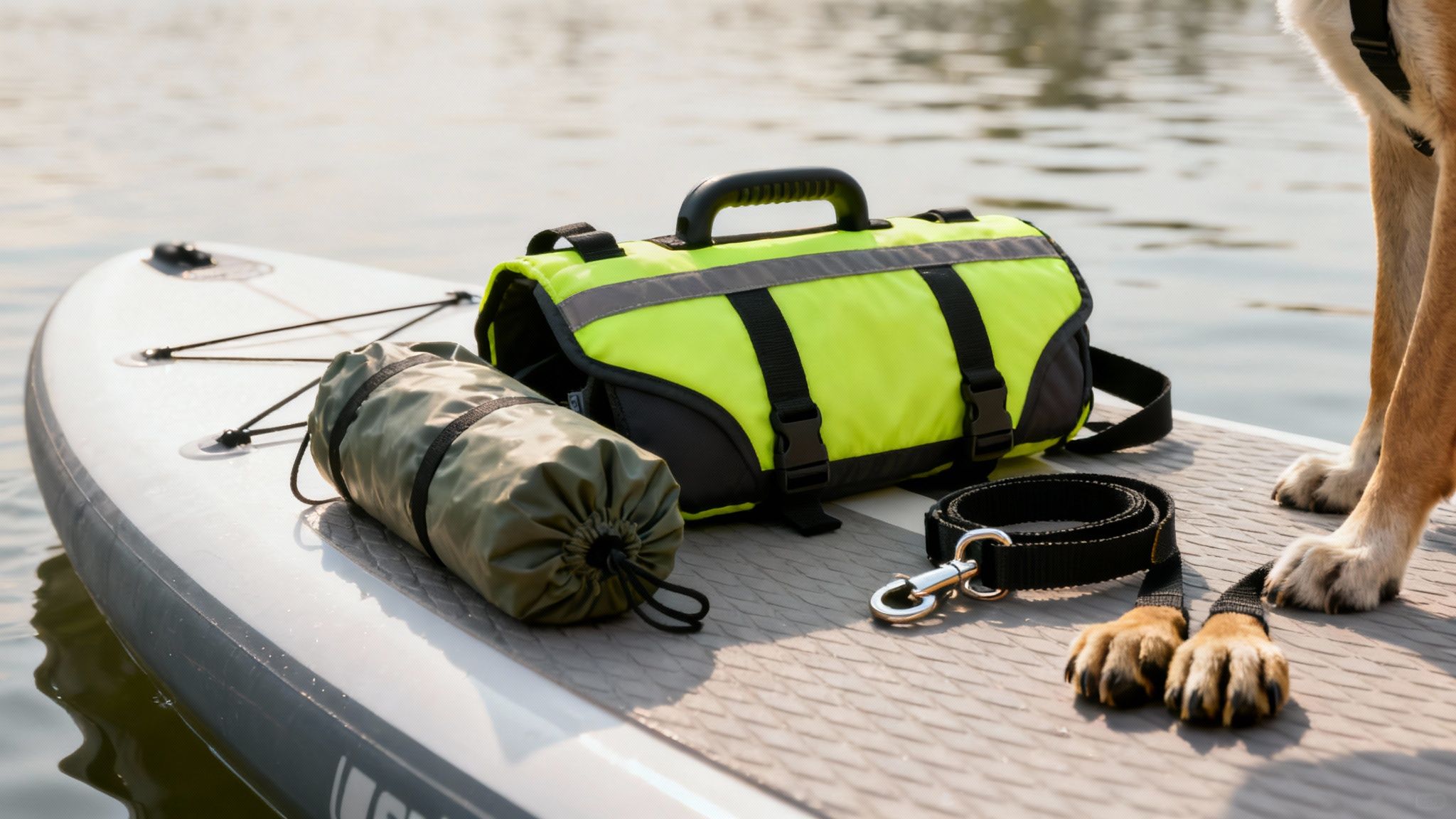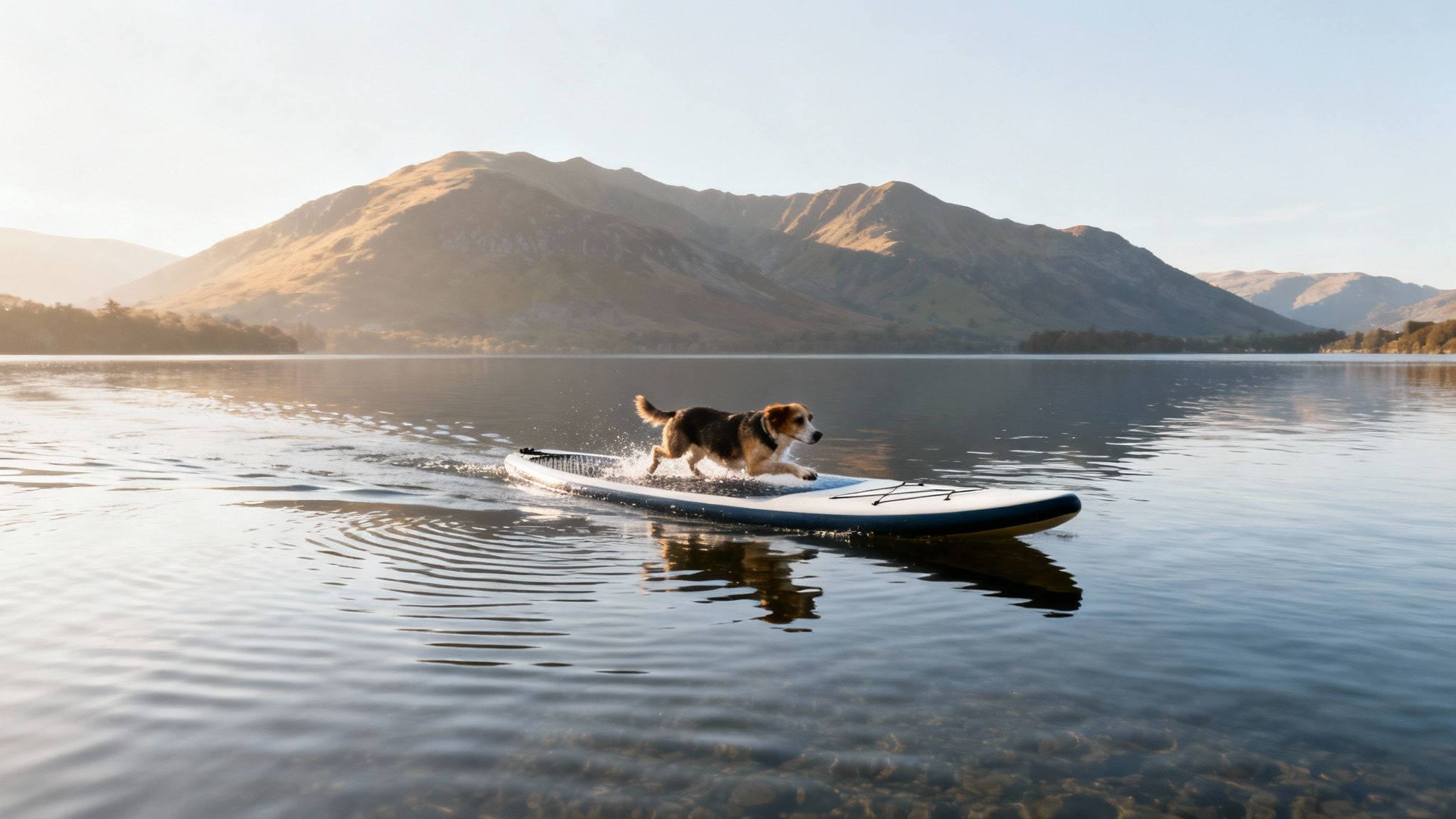Paddle Boarding With Dogs: A Guide to Fun and Safety

Taking your dog paddle boarding is one of those experiences that just sticks with you. It’s a brilliant mix of exercise, mental workout for your pup, and just pure quality time out on the water. It’s about more than just paddling; it's an adventure that really builds the bond between you and your best mate. This guide is here to get you ready for your first trip, helping you picture that peaceful glide across a lake and understand why so many dog owners are getting hooked.
Why Paddle Boarding With Your Dog Is An Unforgettable Experience

Sharing a paddle board with your four-legged friend is about building trust and learning to communicate without words. Picture it: the quiet lap of water against your board, your dog’s ears twitching at all the new sights and sounds. It's these shared moments of discovery that create memories you'll talk about for years.
The boom in dog-friendly water sports really isn't a surprise. A recent survey found that over 26% of active dog owners now regularly take their dogs Stand Up Paddleboarding, making it one of the fastest-growing outdoor activities for people with pets. It just goes to show how many people are discovering the joy of hitting the water together.
The Benefits for You and Your Pup
Paddle boarding with your dog is a world away from just another walk in the park. For you, it’s a fantastic full-body workout. For your dog, it's a new kind of low-impact exercise that’s brilliant for their joints.
Especially for older or very active dogs, you'll want to keep their joints in top nick before and after your paddles. It’s worth looking into natural dog joint supplements to help keep them comfortable and ready for the next adventure.
It's also incredible mental stimulation for your dog. A brand-new environment, combined with the challenge of keeping their balance, engages their brain in a completely fresh way.
Your calm and confident vibe on the board is the single most important thing. If you're relaxed, your dog will pick up on that and feel secure enough to enjoy the ride.
Think about a high-energy border collie who needs a constant job to do—they’ll find the challenge of balancing on a wobbly board incredibly rewarding. Or a water-mad Labrador who will be in their element, enjoying a safe, supervised swim. Every trip becomes a team effort, strengthening your partnership as you both learn to work together on the water.
Choosing the Right Paddle Board for You and Your Pup
Getting the right board is easily the most important decision you'll make when you decide to take your dog paddle boarding. This isn't just about what works for you anymore; it's a shared space that has to be stable, roomy, and tough enough for both of you. Nail this choice, and you're setting yourself up for countless amazing days out on the water.
You've got two main choices: traditional hardboards (usually epoxy or fibreglass) and modern inflatable SUPs (iSUPs). While hardboards have their moments, for paddling with a dog, an inflatable is almost always the way to go. They offer a much softer, more forgiving surface that’s kinder on your dog’s paws and gives them way better grip, especially when things get a bit wet.
Why Inflatables Are a Dog's Best Friend
High-quality iSUPs are incredibly durable. If you're picturing a flimsy pool toy, think again. Modern inflatables are built from military-grade PVC, which makes them seriously resistant to punctures from dog claws.
A huge advantage is the full-length deck pad you find on many models. This non-slip surface gives your dog the confidence to move around without feeling like they’re on an ice rink. A board like the Loco Amigo Air, for example, is one of the best all-around inflatable paddle boards precisely because it was designed with this kind of shared adventure in mind. It gives you a massive, grippy surface for your furry first mate.
That slight give in an inflatable's surface is a real game-changer. It absorbs the little movements from a shifting dog, which makes the whole ride feel far more stable and secure for both of you compared to a rigid hardboard.
Key Features for a Pup-Friendly SUP
When you're weighing up different boards, there are a few features that are simply non-negotiable for keeping things safe and fun.
- Stability is Everything: You need a board that's at least 32 inches wide, but honestly, 33-34 inches is even better. A wider board creates a much more stable platform, which is absolutely crucial when you've got a four-legged friend on board who might decide to change position without warning.
- Ample Volume and Weight Capacity: The board's volume, measured in litres, dictates how buoyant it is. You have to factor in your weight, your dog's weight, and any gear you're bringing along. For example, if you weigh 80kg and your Labrador is 30kg, you need a board that can easily handle at least 110kg plus gear. The Loco Amigo Air has a generous volume, ensuring it rides high on the water and doesn't feel sluggish.
- A Large, Grippy Deck Pad: A textured EVA foam deck pad that covers most of the board is essential. It gives your dog a secure spot to sit or lie down without slipping and sliding.
- D-Rings and Bungees: Look for boards with plenty of D-rings and bungee storage, usually at the front or back. These are perfect for clipping on a dry bag with your dog’s water bowl, treats, and your own essentials.
Paddle Board Comparison For Paddling With Dogs
Choosing between an inflatable and a hardboard can feel tricky, but when you break it down, the best option for paddling with a dog becomes pretty clear. This table highlights the key differences.
| Feature | Inflatable SUP (e.g., Loco Amigo Air) | Hardboard (Epoxy/Fibreglass) | Why It Matters For Dogs |
|---|---|---|---|
| Surface & Grip | Soft, forgiving PVC with a large EVA deck pad. | Hard, slick surface, often with a smaller deck pad. | The softer surface is easier on paws and claws. Better grip means a more confident and comfortable dog. |
| Durability Against Claws | High-quality, military-grade PVC is extremely puncture-resistant. | Can be scratched or chipped by claws, potentially costly to repair. | You can relax knowing your dog’s claws won't damage the board. |
| Stability | Wider models offer fantastic stability, absorbing minor movements. | Can feel tippier as every movement from the dog is transferred directly. | A more stable ride means fewer wobbles and a lower chance of an unexpected swim for either of you. |
| Portability & Storage | Deflates to fit in a backpack. Easy to transport and store. | Bulky, requires a roof rack and significant storage space. | Less hassle getting to and from the water, which means you're more likely to go paddling more often. |
| Weight Capacity | High volume and buoyancy can support significant combined weight. | Varies, but can be less buoyant at comparable sizes. | Ensures the board rides high and dry, even with a larger dog and all your gear. |
Ultimately, while a hardboard might offer a slight edge in speed, an inflatable SUP wins on almost every front for safety, comfort, and practicality when you have a dog on board.
This chart really drives home how much board shape affects stability, which is your number one priority with a pup.

As you can see, a wide, all-around board offers the highest stability rating by a long shot, making it the perfect choice for a relaxed and secure paddle with your dog. A narrow racing board, while quick, is just far too wobbly to be safe or enjoyable with a canine companion. Getting the shape right is the key to a good time for everyone.
Essential Gear For Your Dog's Safety And Comfort

So, you've got the right board. Now it's time to kit out your pup for a safe and brilliant day on the water. When you're paddling with your dog, safety isn't just a nice-to-have; it's everything. Having the right gear sorted beforehand means you can both relax and just enjoy the experience.
The single most important bit of kit is a canine buoyancy aid, or doggy life jacket. Even the strongest swimmers can panic or tire if they suddenly find themselves in the water. A good, well-fitting vest not only keeps them afloat but, crucially, has a sturdy, reinforced handle on the back. This handle is an absolute lifesaver for getting them back onto the board, turning what could be a frantic scramble into a simple lift. It's worth having a read about the best paddle board life vests for comfort and safety to really understand what to look for.
Your Leash System Matters
The way you set up your leash is a huge safety consideration. Never, and I mean never, attach your board's ankle leash to yourself when your dog is on board. If you both fall off on opposite sides, the leash can create a seriously dangerous entanglement risk for both of you. The proper way to do it is with a quick-release waist belt system, which lets you completely detach from your board in an instant if you need to.
Remember, the goal is to keep you both safe and independent of each other in the water. A quick-release system is the industry standard for safe paddling and is absolutely essential when a dog is involved.
Packing for Comfort and Practicality
Beyond the big safety items, a few creature comforts will make your trip much smoother. Think about your launch spot. For example, if you're setting off from a shingle beach in Brighton or a rough, stony slipway in the Lake District, dog booties are a great idea to protect their paw pads from cuts and scrapes.
It's also a good idea to pack a dedicated "doggy bag" – a waterproof one, of course, that you can clip onto your board's D-rings. Loco's durable dry bags are perfect for stashing all their bits and pieces.
Essential Doggy Day-Bag Checklist:
- Fresh Water and a Collapsible Bowl: Never let them drink from the lake or sea. Always bring plenty of fresh water to keep your pup properly hydrated.
- High-Value Treats: Brilliant for rewarding good, calm behaviour on the board and making the whole thing a positive experience. For example, small pieces of chicken or cheese work wonders.
- A Towel: You'll be glad you have it when it's time to dry them off. A wet dog can get cold quickly, even on a sunny day.
- Dog-Friendly Sunscreen: Yep, dogs get sunburnt too! Their nose and the tips of their ears are particularly sensitive.
- Waste Bags: Always follow the "leave no trace" rule. What you bring with you, you take home.
Being a responsible owner means planning for everything. Along with your paddle gear, you'll need to be ready for clean-ups. For some extra tips, this guide to hygienic and eco-friendly dog waste disposal is a handy resource. Get the gear sorted, and you can focus on the fun.
Training Your Dog For The Paddle Board
That perfect day out on the water with your best mate doesn't just happen by magic. It's the result of patient groundwork, built long before you even think about getting wet. The whole idea is to make the board a fantastic, positive place for your dog. Rushing it is the quickest way to end up with a nervous pup, so think of this as a new game you're learning together.
Get started in a familiar, low-stress spot like your garden. Just lay the board down on the grass – a nice stable inflatable like the Loco Amigo Air is perfect for this. Let your dog have a good sniff and explore it on their own terms. Pop a few of their favourite treats on the deck pad to reward that curiosity and coax them into stepping on board.
Building Confidence On Dry Land
Your first mission is to convince your dog that the paddle board is the best place on earth. Come up with a clear, happy command like 'on' or 'board', and the second their paws touch the deck, shower them with praise and treats. Never force them; the goal is to lure them on so it feels like their decision.
Once they’re happily hopping on, it's time to teach them to settle. Ask for a 'sit' or a 'down' and reward them for staying put. Keep these first sessions super short and sweet – a minute or two is more than enough. Always end on a high note before they can get bored, which really hammers home that the board is a place for fun and rewards. This foundation is crucial for any dog, but it's an absolute must for pups on the anxious side. If that sounds like your dog, you might find our specific guide on paddleboarding with anxious dogs helpful.
Every dog is different, so you've got to read the room and tailor your approach.
- For a Timid Dog: A shy Springer Spaniel might not even want to go near the board at first. With a nervous dog, every tiny step forward is a massive win. Reward them just for sniffing it, then for putting one paw on, then two. Use lots of calm praise and keep sessions extra short to build that vital trust.
- For an Excited Dog: Your bouncy Labrador might be leaping on and off like a pogo stick. With an energetic dog, the real challenge is teaching them to be calm. Only reward them when all four paws are on the board and they're still. You'll be practising the 'settle' command a lot until they figure out that chilling out is what gets them the good stuff.
Making The Move To Water
Right, so your dog is now a pro at getting on the board and settling down in the garden. It's time to head to the water's edge. Find somewhere very shallow and calm – a gentle lake shore or a quiet bit of beach is ideal. That first time the board wobbles underneath them can be a bit spooky, so it's your job to be their anchor.
Start with the board still touching the land, half in the water. Get them to hop on, using the same commands and rewards they know from your garden sessions. Hold the board rock-steady for them. Then, slowly push off into just a few inches of water, keeping it as stable as you can while they get used to this new feeling of gentle movement.
The secret ingredient to all successful SUP dog training is patience. It's no accident that dog paddleboarding has taken off in the UK; it's because owners have learned to take it slow, starting on land before graduating to the shallows to build up confidence step by step.
Keep these first few on-water sessions brief and massively positive. Stick to the shallows where you can easily stand and steady the board. Your only job here is to reward calm behaviour as they get used to the new sensations. This slow and steady introduction builds a deep well of trust, which is what will make all your future adventures on the water both safe and incredibly fun for you both.
Best UK Locations For Paddle Boarding With Dogs

The UK is absolutely packed with incredible spots perfect for a paddle with your dog, from glassy lakes to sheltered coastal bays. Finding the right location is key to a fun and safe day out, especially when you and your pup are just getting the hang of it. The main goal is to match the water conditions to your combined confidence levels.
Choosing calm, sheltered water is the best way to build a positive association for your dog. Think about spots with easy launch points, like a sandy beach or a gentle slipway. You'll want to avoid steep, rocky banks that can be a nightmare for paws and boards alike.
Calm Waters For Beginners
For anyone new to paddling with a canine co-pilot, the Lake District is an obvious and frankly brilliant choice. A spot like Derwentwater, near Keswick, gives you stunning scenery and generally calm conditions, with loads of small bays to explore at your own pace.
Another fantastic option is the Norfolk Broads. This huge network of rivers and lakes is mostly sheltered from the wind, offering up miles of flat water that's perfect for finding your balance together. You can paddle between picturesque villages, keeping your first few sessions short, sweet, and enjoyable.
A location's dog-friendliness goes beyond just the water. Always check for a nearby dog-friendly pub for a post-paddle pint, and be mindful of local rules, especially around nesting birds during certain seasons.
Coastal Adventures For The More Experienced
Once you're both feeling steady on flat water, you might be tempted by a sheltered coastal route. Dorset's coastline has some superb options. Studland Bay, with its calm, clear water and sandy shores, is a massive hit with SUP enthusiasts and their four-legged friends.
The UK's passion for paddling with pups is growing fast. In fact, the UK Dog Surfing Championships at Branksome Dene Chine in Dorset saw competitors set multiple Guinness World Records. Two teams now co-hold the record for the fastest 50-metre paddle by a human-dog pair, which just shows how seriously fun this sport has become.
Before heading out, it's always smart to do a bit of research on your chosen spot. For a wider selection of tried-and-tested locations, take a look at our guide to the best UK paddle board locations, which has detailed insights for all skill levels.
When you're ready for more of a challenge, you could check out places like these:
- Cuckmere Haven, East Sussex: Paddle along the meandering river out to the sea, with those iconic views of the Seven Sisters cliffs. It's best tackled on a calm day at high tide.
- Loch Lomond, Scotland: The sheer size of the loch means you can almost always find a quiet, sheltered corner to explore. The southern end is particularly good for beginners.
- Pembrokeshire Coast, Wales: For experienced duos, the sheltered harbours like Solva offer a stunning backdrop for a coastal paddle. Just be sure to check the tide times and wind forecast religiously.
Answering Your Questions About SUP With Dogs
Even with all the best preparation, it's completely normal to have a few last-minute questions buzzing around your head before you and your pup hit the water. Getting those queries sorted can be the difference between feeling nervous and feeling nothing but pure excitement for your first trip together.
Let’s tackle some of the most common questions we hear.
What Is The Best Type Of Dog For Paddle Boarding?
This is a classic one. While you might picture a Golden Retriever or a Labrador leaping gracefully into the water, the truth is, the "best" dog for paddle boarding is less about breed and more about personality.
It really comes down to a calm temperament and a dog who is at least comfortable, if not confident, around water. I've seen chilled-out rescue mongrels take to it like a duck to water, sometimes even faster than a hyperactive water spaniel who can't sit still!
Your patience during training is the most important factor, followed closely by having the right kit. A super stable, wide platform like the Loco Amigo Air is a game-changer. It's specifically designed to handle the extra weight and movement of bigger breeds or dogs that are a bit more fidgety, giving you both a much more secure base to start from.
How Do I Get My Dog Back On The Board If They Fall In?
Okay, this is a skill you absolutely must practise before you go out into deep water. When your dog decides to go for an unscheduled swim, the number one rule is to stay calm. Your dog will pick up on your energy, so if you panic, they will too.
This is exactly why a canine buoyancy aid with a strong, well-stitched handle isn't just a recommendation—it's non-negotiable.
Here’s the drill:
- First, paddle over to your dog. Place your paddle across the board in front of you to give yourself some extra stability.
- Get down onto your knees near the centre of the board.
- Grab the handle on their life jacket firmly.
- The trick is to lift their front paws onto the board first, then smoothly hoist their back end up in one fluid motion.
Make a point of practising this a few times in shallow water where you can both stand. It builds muscle memory for you and, crucially, teaches your dog that getting back on board is no big deal.
Will My Dog's Claws Damage An Inflatable Paddle Board?
This is probably the single most common worry we hear from dog owners, but I'm here to put your mind at rest. High-quality inflatable paddle boards (iSUPs) are built like tanks. Forget thinking of them like pool toys; these are made with military-grade PVC layers that are incredibly resistant to punctures and abrasion.
We build Loco SUP boards to withstand scrapes from rocky shorelines and the general wear and tear of regular use. A dog's claws, especially if you keep them reasonably trimmed, pose very little threat.
The soft EVA deck pad that covers the top of the board doesn't just provide essential grip for you both; it also adds another protective layer. In fact, an iSUP is often a much better and more durable choice for paddle boarding with dogs than a traditional hardboard, which can get scratched quite easily. Plus, the slightly softer surface of an inflatable is far more comfortable for your dog to lie on during your adventures.
At Loco Surfing, we're passionate about getting you and your furry first mate out on the water safely and with the best gear. Explore our range of dog-friendly inflatable paddle boards and find the perfect ride for your next adventure at https://locosurfing.com.





Leave a comment